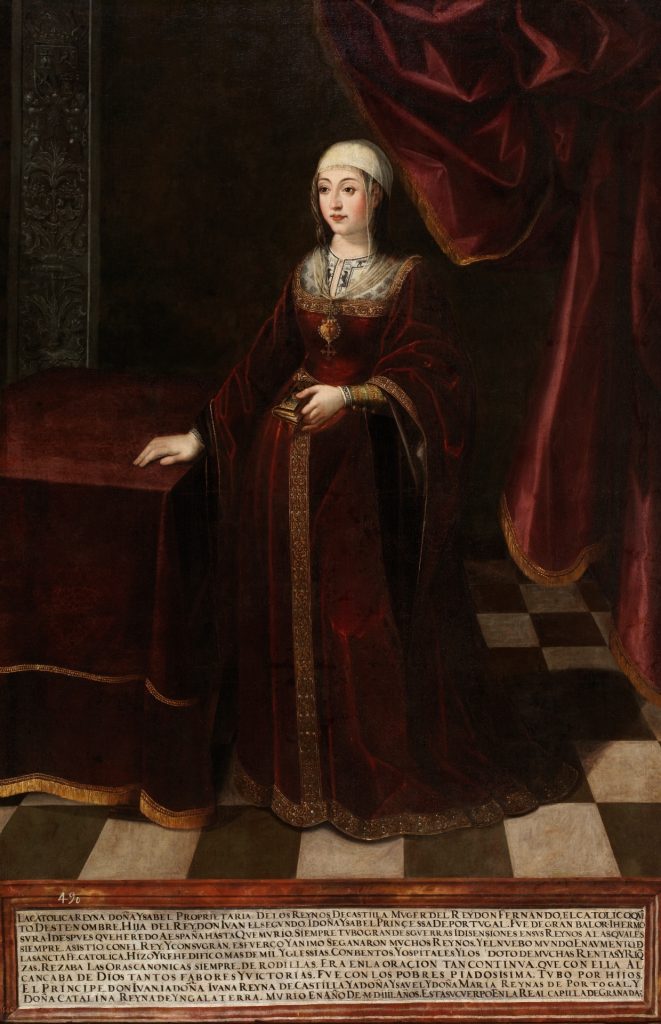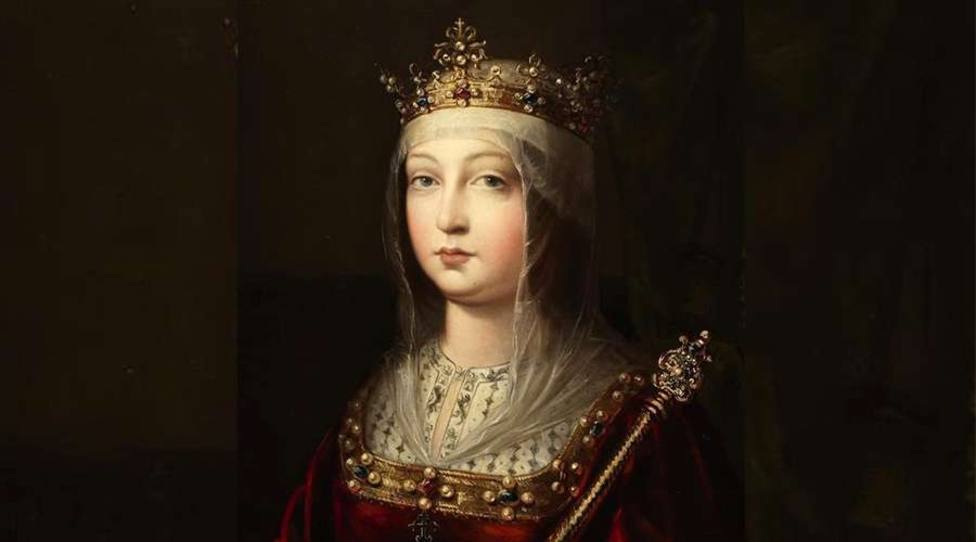Isabella of Castile, a woman who lived in a man’s world where she managed to reign of her own free will. An intelligent woman who built herself and changed history with her own decisions.
She lived in a time of change between the darkness of the Middle Ages and the enlightenment of the Renaissance. Isabella de Castilla, founded the modern Spain with the conquest of Granada in 1492. A long, difficult but determined road that ended with her death in 1504.
A woman with one foot in the Middle Ages, linked to the Catholic religion and fearing God, installing the inquisition, expelling the Jews and then the Moors.
The other foot was in the Renaissance, opening the vision to the horizon with the discoveries, changing the feudal system into a state, installing a professional army and a police control. A transitional woman, who settled the foundations of today’s Spain.
Isabella, from Princess to Queen
Isabella I of Castile (Madrigal de las Altas Torres, April 22, 1451-Medina del Campo, November 26, 1504) was Queen of Castile from 1474 to 1504, Queen consort of Sicily from 1469 and of Aragon from 1479, due to her marriage with Fernando of Aragon.
Henry IV was called “the impotent one.” In his first nuptials he married Blanca de Navarra with whom he could not have children, that marriage was annulled and married Juana de Portugal in 1455. But the King’s luck had not changed and in this marriage neither did an heir arrive.
However, Juana known as Juana La Beltraneja was born, daughter of the Queen and probably daughter of Beltrán de la Cueva, an influential man in the court of King Henry and supposed lover of Juana de Portugal.
After a civil war, Enrique’s half-brother, Juan, Isabella’s younger brother, was elected king at the age of 11, but good fortune did not accompany him and he died 3 years later, in 1468.
And now, who was going to be the successor? Juana or Isabella. Isabella managed to sign an agreement with her stepbrother; the Treaty of the Guisando Bulls, by which Henry declared Isabella heir, reserving the right to agree on her marriage.
Henry, in fact, tried to marry Isabella with Alfonso V, king of Portugal, the Duke of Guyena, brother of Luis XI of France among others but Isabella did not accept. She had promised herself never to marry someone whom she had not previously chosen. And while Henry continued looking for a husband for Isabella, as agreed, Juan II of Aragon tried to secretly negotiate with Isabella the wedding with his son Fernando.
Isabella and her advisers considered that he was the best candidate as husband but there was a legal impediment. Since they were second cousins, (her parents were cousins) they needed, therefore, a papal bull that would exonerate them of consanguinity.
The Pope, however, did not get to sign this document, fearful of the possible negative consequences that this act could bring him by attracting the enmity of the kingdoms of Castile, Portugal and France.
People around Isabella falsified an alleged bull issued in June 1464 by the previous Pope, Pius II, in favor of Ferdinand, in which he was allowed to marry any princess with whom he was linked by a consanguinity tie of up to a third grade.
Ferdinand crossed Castile in secret, disguised as a merchant’s mule waiter, and thus reached Castile and met Isabella.
Between suspicions and uncertainties, Isabella finally married in secret in 1469 Ferdinand of Aragon, son of King Juan II of Aragon, cousin of Juan II of Castile. But with this marriage, the agreement of the Guisando Bulls was broken and Henry proclaimed his daughter Juana as his successor.
The kingdom fell into anarchy but Isabella and Fernando sought the support of the nobles of Castile and regain the confidence of a Kingdom.
Another unfortunate news came in 1474, the death of Henry. At that moment in which Isabella crowned herself Queen of Castile and thus began the war of succession between Juana and Isabella. In 1479, Isabella and Fernando finally legitimize themselves as Kings of Castile.

During her reign, together with Fernando, events of great significance for the future of the kingdom occurred, such as the establishment of the Holy Inquisition (1478), the creation of the Holy Brotherhood, the incorporation of the Nasrid Kingdom of Granada, as well as the religious unification of the Hispanic Crown, based on the forced Conversion of the Jews, under pain of death or expulsion (Edict of Granada, 1492) and later on to the Muslims.
It is important to highlight this feature of the personality of Elizabeth I, very visible in her conception of how the government of the recently incorporated Fortunate Islands should be carried out, to understand how the project of Christopher Columbus, which had been rejected by other European kings , found accommodation within Isabella the Catholic to the point of financing the Columbian plan.
Isabella had five children with Fernando who had had other children before her marriage and probably afterwards as well…
She instructed her sons: Isabella, Juan, Juana I of Castile, María and Catalina, that they had obligations for their rank as sons of kings, and they had to sacrifice a lot for that reason. She took them with her during the military campaigns, but she also always watched over their well-being.
At the end of her days, she suffered most of the family misfortunes such as the death of her only son and the abortion of his wife, the death of her first-born and her grandson Miguel who was destined to unify the Kingdoms of the Catholic Kings with that of Portugal.
It was followed by the alleged “madness” of her daughter Juana who openly defied her mother in Medina del Campo or the uncertainty of her daughter Catalina after the death of her English husband. There were several misfortunes that led her to decide to dress in full mourning.
The court was in Medina del Campo, when her serious illness, dropsy, was confirmed, as Pedro Mártir said as a witness. But she finally died of uterine cancer.
Isabella, aware of the outcome, ordered the Masses for her health to be made for her soul, she asked for extreme unction and the Blessed Sacrament. Isabella of Castile, having granted her will on October 12, died shortly before noon on November 26, 1504, in the Royal Palace where she requested …
… My body is to be buried in the monastery of San Francisco, which is in the Alhambra in the city of Granada, in a low grave with no bulk, except for a low slab on the ground, flat, with her letters on it. But I want and command, that if the King chose burial in another church or monastery in any other part or place of these my kingdoms, that my body be transferred there and buried next to him …
Finally, Fernando de Aragon ordered the construction of the Royal Chapel and chose Dominico Fancelli to sculpt the mausoleum of both Kings. Fancelli had previously built the mausoleum for his son Juan in the Royal Monastery of Santo Tomas in Avila and for that reason he met the Kings.
What could have happened if she had married the king of Portugal or if she had let Columbus go and France had discovered America? What if she had not proclaimed herself Queen of Castile? What if in the civil war his niece Juana la Beltraneja had won the throne of Castile? This gives us an idea of the crucial decisions she had to make throughout her life as queen.
Isabella of Castile is called “the Catholic”, a title that was granted to her by Pope Alexander VI through the bull “Si Convenit”, on December 19, 1496. This is why the royal couple is known by the name of Catholic Monarchs, a title that the different kings of Spain used from that moment on.



